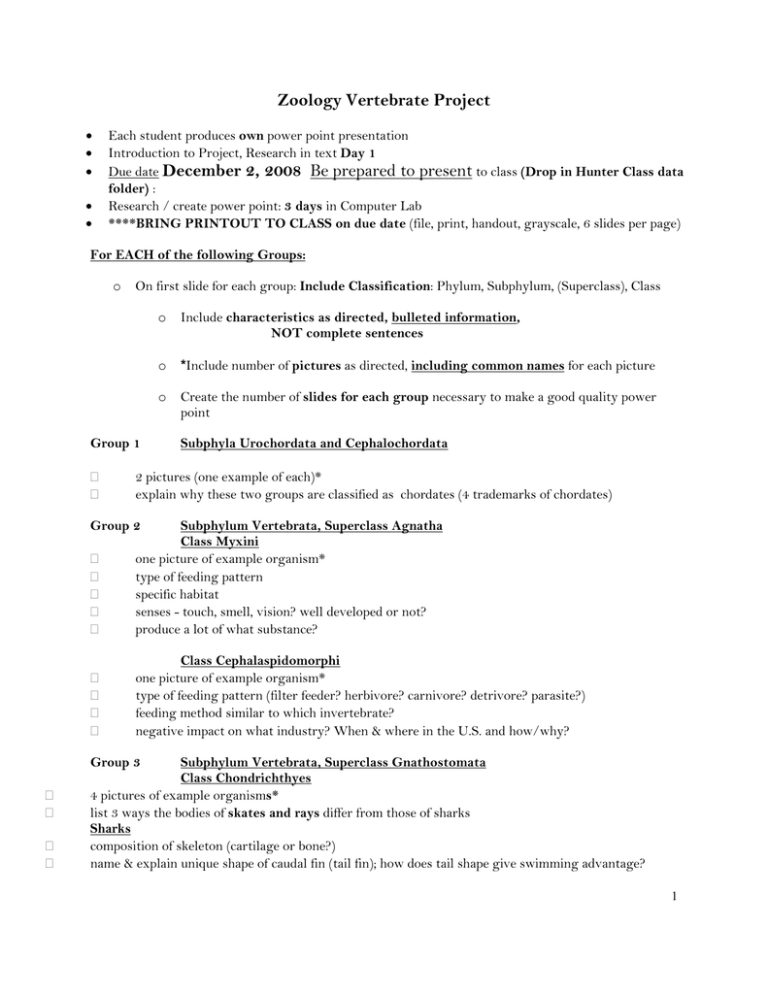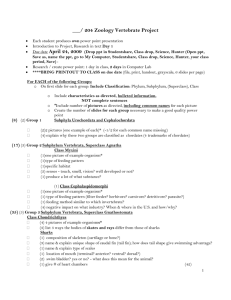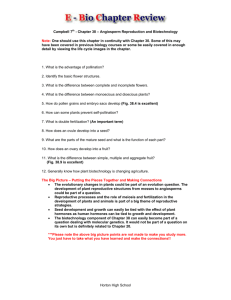Zoology Vertebrate Project December 2, 2008 Be prepared to present
advertisement

Zoology Vertebrate Project • • • • • Each student produces own power point presentation Introduction to Project, Research in text Day 1 Due date December 2, 2008 Be prepared to present to class (Drop in Hunter Class data folder) : Research / create power point: 3 days in Computer Lab ****BRING PRINTOUT TO CLASS on due date (file, print, handout, grayscale, 6 slides per page) For EACH of the following Groups: o On first slide for each group: Include Classification: Phylum, Subphylum, (Superclass), Class Group 1 o Include characteristics as directed, bulleted information, NOT complete sentences o *Include number of pictures as directed, including common names for each picture o Create the number of slides for each group necessary to make a good quality power point Subphyla Urochordata and Cephalochordata 2 pictures (one example of each)* explain why these two groups are classified as chordates (4 trademarks of chordates) Group 2 Subphylum Vertebrata, Superclass Agnatha Class Myxini one picture of example organism* type of feeding pattern specific habitat senses - touch, smell, vision? well developed or not? produce a lot of what substance? Class Cephalaspidomorphi one picture of example organism* type of feeding pattern (filter feeder? herbivore? carnivore? detrivore? parasite?) feeding method similar to which invertebrate? negative impact on what industry? When & where in the U.S. and how/why? Group 3 Subphylum Vertebrata, Superclass Gnathostomata Class Chondrichthyes 4 pictures of example organisms* list 3 ways the bodies of skates and rays differ from those of sharks Sharks composition of skeleton (cartilage or bone?) name & explain unique shape of caudal fin (tail fin); how does tail shape give swimming advantage? 1 name & explain type of scales location of mouth (terminal? anterior? ventral? dorsal?) swim bladder? yes or no? - what does this mean for the animal? describe heart (# of chambers) reproductive patterns - monoecious or dioecious ? - fertilization type (internal? external?) - oviparous, ovoviviparous, or viviparous? [define all three term(s)] - what reproductive pattern(s) do sharks have? unique sense organs - describe how they detect vibrations & electrical fields (what organ, where are organs located?) - smell vs. vision (how well does each work? which is better developed?) Group 4 Subphylum Vertebrata, Superclass Gnathostomata Class Osteichthyes 4 pictures of example organisms * 2 main types of bony fish (Hint: types of fins) composition of skeleton (cartilage or bone?) name & explain shape of caudal fin (tail fin) name & explain type(s) of scales location of mouth (terminal? anterior? ventral? dorsal?) swim bladder? – yes or no? what does this mean for the animal? describe heart (# of chambers) reproductive patterns - monoecious or dioecious ? - fertilization type (internal? external?) -oviparous, ovoviviparous, or viviparous? (define term(s) you use) Group 5 Subphylum Vertebrata Class Amphibia 4 pictures of example organisms * describe skeleton (heavy? light? how are pectoral & pelvic girdles attached?) full rib cage or no? number of limbs, number of digits on each limb (name & specify #s for exceptions); claws? describe body covering (scales? no scales? smooth skin?) -identify 3 types of skin glands and their functions generally describe different methods of respiration (including adult vs. larval forms) describe heart (# of chambers) define ectothermy; are amphibians warm or cold blooded? reproductive patterns - monoecious or dioecious ? - fertilization type (internal? external?) frogs & toads vs. salamanders? - oviparous, ovoviviparous, or viviparous? (define term(s) you use) - name egg covering, what does this mean about where eggs must be laid? - larval stages – habitats? feeding patterns? Group 6 Subphylum Vertebrata Class Reptilia 4 pictures of example organisms * describe skeleton, specify how it differs from amphibian skeleton; define skull types 2 number of limbs, number of digits; claws? describe body covering (scales or not?) describe heart (# of chambers); crocodiles vs. other reptiles respiration via what organs? ectothermic or endothermic? reproductive patterns - monoecious or dioecious ? - fertilization type (internal? external?) - what type of egg ( name & describe) - describe egg covering, explain significance of this covering Group 7 Subphylum Vertebrata Class Aves 4 pictures of example organisms * describe skeletal modifications (for flight) - how does bone structure differ from those of reptiles? significance? - beaks? composition of same? - teeth? - sternum or none? Significance & function of keel? describe number of limbs and limb forms describe body coverings (what & where?) respiration via what structures? - name structure for making sound function 0f air sacs describe heart (# of chambers) ectothermic or endothermic? reproductive patterns - monoecious or dioecious ? - fertilization type - describe egg type (explain) & covering Group 8 Subphylum Vertebrata Class Mammalia 4 pictures of example organisms * body covered with what? what location of fat deposits? skin (a.k.a. ______________) - list 4 specific types 0f skin glands and their functions respiration via what structures? - include which muscle aids in respiration - sound produced in which structure? describe heart (# of chambers) define homeothermic reproductive patterns - monoecious or dioecious ? - fertilization type briefly state how egg development & embryonic nutrition works in the following, emphasizing how they differ from each other 3. Placental 1. Monotremes 2. Marsupials. mammals 3




